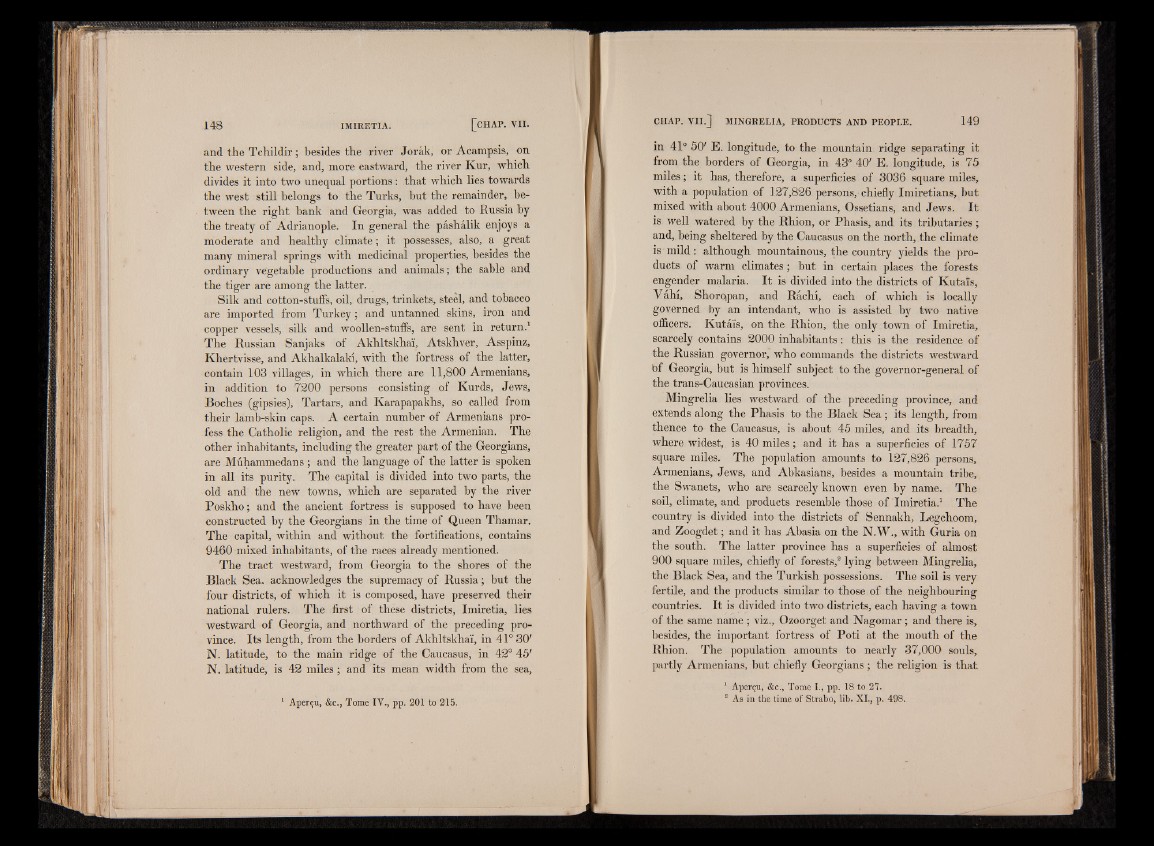
and the Tchildir; besides the river Jorak, or Acampsis, on
the western side, and, more eastward, the river Kur, which,
divides it into two unequal portions: that which lies towards
the west still belongs to the Turks, but the remainder, between
the right hank and Georgia, was added to Russia by
the treaty of Adrianople. In general the pashalik enjoys a
moderate and healthy climate; it possesses, also, a great
many mineral springs with medicinal properties, besides the
ordinary vegetable productions and animals; the sable and
the tiger are among the latter.
Silk and cotton-stuffs, oil, drugs, trinkets, steel, and tobacco
are imported from Turkey; and untanned skins, iron and
copper vessels, silk and woollen-stuffs, are sent in return.1
The Russian Sanjaks of Akhltskhai, Atskhver, Asspinz,
Khertvisse, and Akhalkalaki, with the fortress of the latter,
contain 103 villages, in which there are 11,800 Armenians,
in addition to 7200 persons consisting of Kurds, Jews,
Boches (gipsies), Tartars, and Karapapakhs, so called from
their lamb-skin caps. A certain number of Armenians profess
the Catholic religion, and the rest the Armenian. The
other inhabitants, including the greater part of the Georgians,
are Muhammedans ; and the language of the latter is spoken
in all its purity. The capital is divided into two parts, the
old and the new towns, which are separated by the river
Poskho; and the ancient fortress is supposed to have been
constructed by the Georgians in the time of Queen Thamar.
The capital, within and without the fortifications, contains
9460 mixed inhabitants, of the races already mentioned.
The tract westward, from Georgia to the shores of the
Black Sea. acknowledges the supremacy of Russia; but the
four districts, of which it is composed, have preserved their
national rulers. The first of these districts, Imiretia, lies
westward of Georgia, and northward of the preceding province.
Its length, from the borders of Akhltskhai, in 41° 30'
N. latitude, to the main ridge of the Caucasus, in 42° 45'
N. latitude, is 42 miles; and its mean width from the sea,
1 Apercju, &c., Tome IV., pp. 201 to 215.
in 41° 50' E. longitude, to the mountain ridge separating it
from the borders of Georgia, in 43° 40' E. longitude, is 75
miles; it has, therefore, a superficies of 3036 square miles,
with a population of 127,826 persons, chiefly Imiretians, but
mixed with about 4000 Armenians, Ossetians, and Jews. It
is well watered by the Rhion, or Phasis, and its tributaries;
and,, being sheltered by the Caucasus on the north, the climate
is mild: although mountainous, the country yields the products
of warm climates; but in certain places the forests
engender malaria. It is divided into the districts of Kutais,
Vahi, Shorqpan, and Radii, each of which is locally
governed by an intendant, who is assisted by two native
officers. Kutais, on the Rhion, the only town of Imiretia,
scarcely contains 2000 inhabitants: this is the residence of
the Russian governor, who commands the districts westward
bf Georgia, but is himself subject to the governor-general of
the trans-Caucasian provinces.
Mingrelia lies westward of the preceding province, and
extends along the Phasis to the Black Sea; its length, from
thence to the Caucasus, is about 45 miles, and its breadth,
where widest, is 40 miles; and it has a superficies of 1757
square miles. The population amounts to 127,826 persons,
Armenians, Jews,, and Abkasians, besides a mountain tribe,
the Swanets, who are scarcely known even by name. The
soil, climate, and products resemble those of Imiretia.1 The
country is divided into the districts of Sennakh, Legchoom,
and Zoogdet; and it has Abasia on the N.W., with Guria on
the south. The latter province has a superficies of almost
900 square miles, chiefly of forests,8 lying between Mingrelia,
the Black Sea, and the Turkish possessions. The soil is very
fertile, and the products similar to those of the neighbouring
countries. It is divided into two districts, each having a town
of the same name ; viz., Ozoorget and Nagomar; and there is,
besides, the important fortress of Poti at the mouth of the
Rhion. The population amounts to nearly 37,000 souls,
partly Armenians, but chiefly Georgians ; the religion is that
1 Aperiju, &c., Tome I., pp. 18 to 21.
2 As in the time of Straho, lib. XI., p. 498.